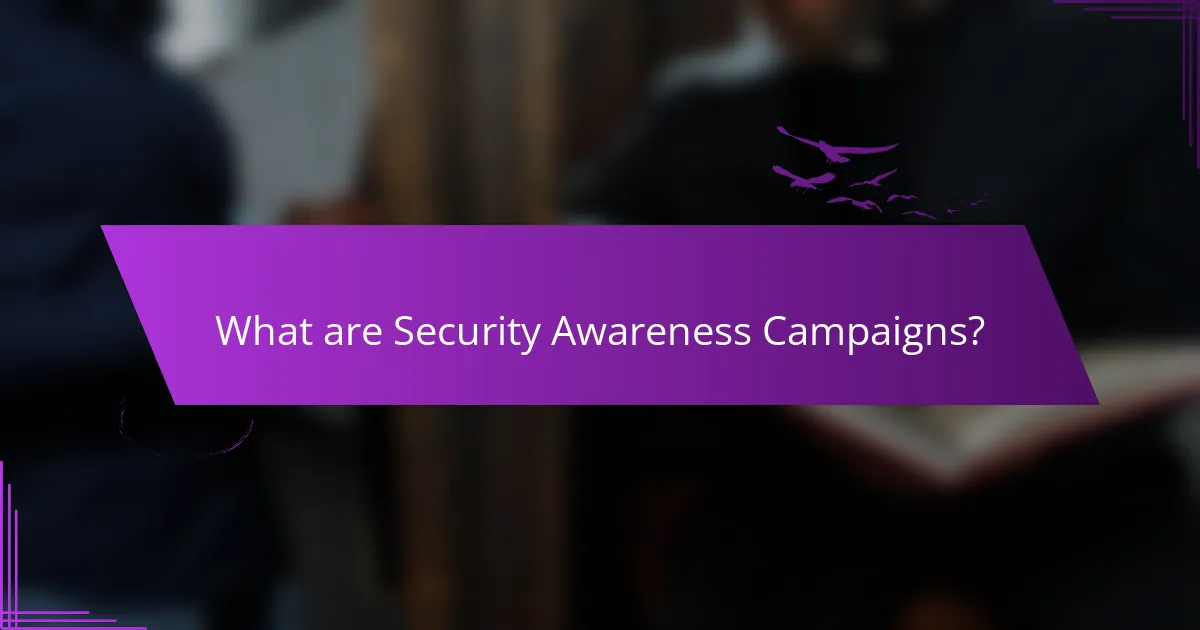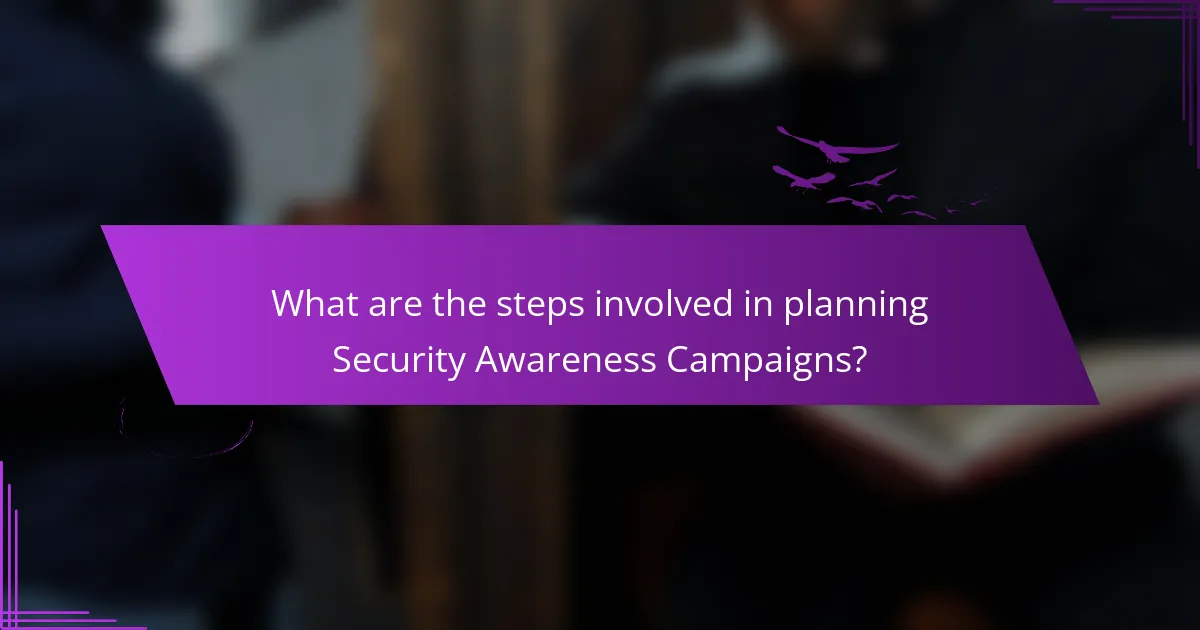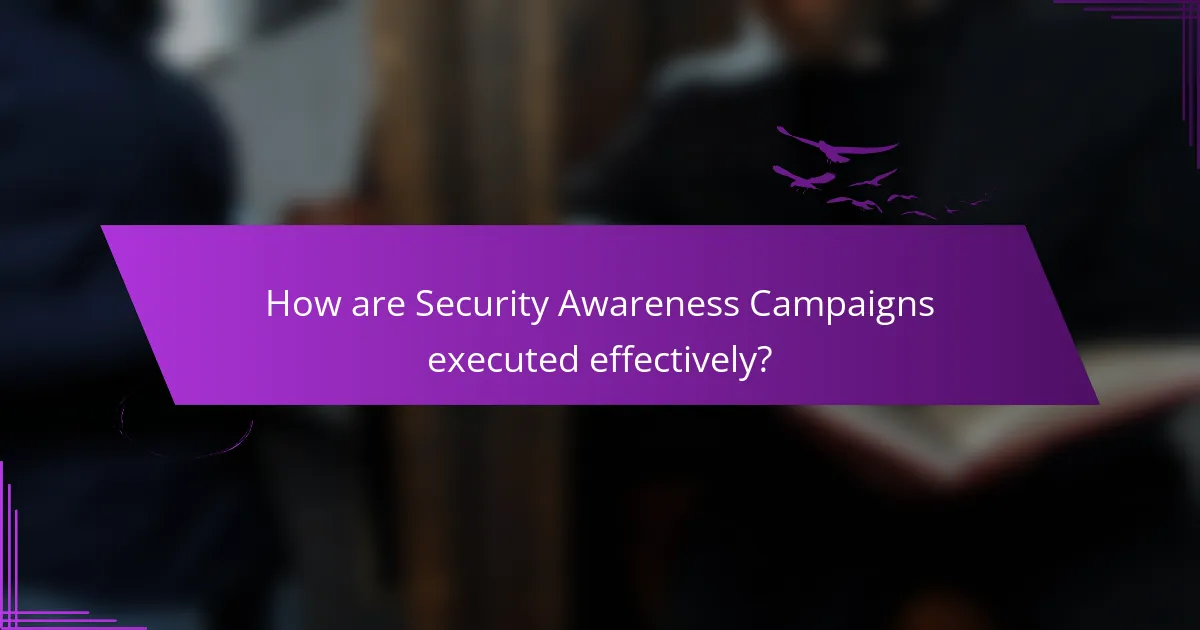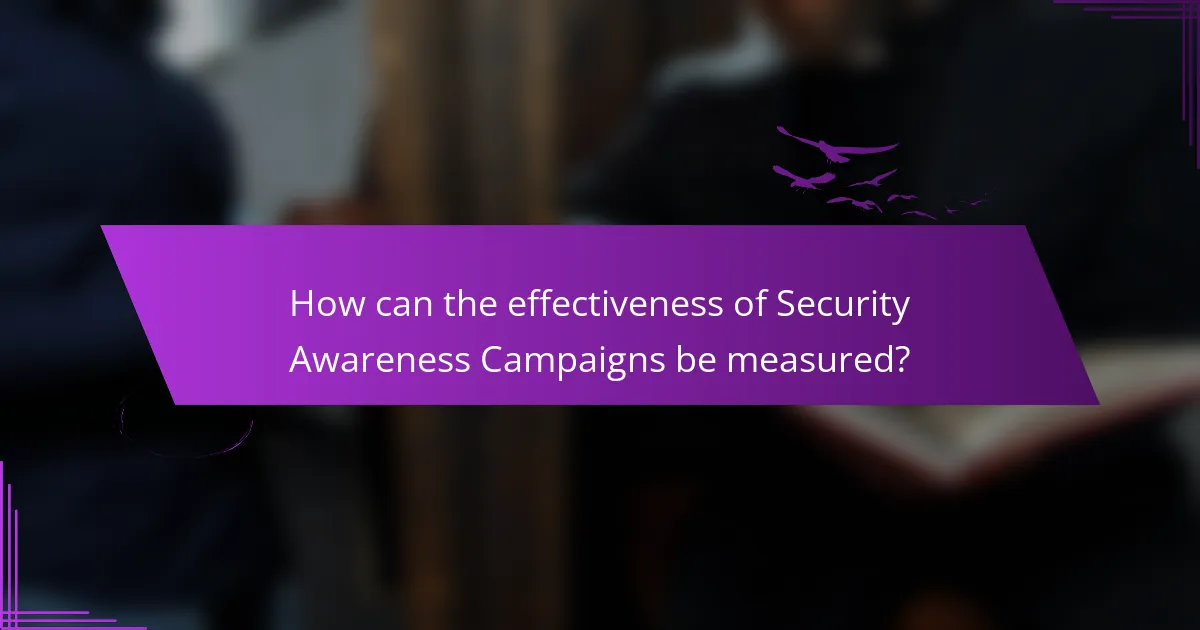
What are Security Awareness Campaigns?
Security awareness campaigns are structured initiatives designed to educate individuals about security risks and safe practices. These campaigns aim to enhance knowledge and promote behaviors that mitigate security threats. They often include training sessions, informational materials, and interactive activities. The goal is to reduce incidents of security breaches and improve an organization’s overall security posture. Research indicates that organizations with effective security awareness programs can reduce phishing incidents by up to 70%.
How do Security Awareness Campaigns function?
Security awareness campaigns function by educating individuals about security risks and best practices. They utilize various methods such as training sessions, newsletters, and interactive activities. These campaigns aim to change behaviors and foster a security-conscious culture. Effective campaigns assess the audience’s knowledge and tailor content accordingly. They often include real-life examples of security breaches to illustrate risks. Measurement of effectiveness involves tracking engagement and behavior changes over time. Statistics show that organizations with robust security awareness programs reduce incidents by up to 70%. This evidence supports the efficacy of these campaigns in enhancing overall security posture.
What key elements are essential for effective Security Awareness Campaigns?
Effective Security Awareness Campaigns require clear objectives, tailored content, engaging delivery methods, and continuous evaluation. Clear objectives define what the campaign aims to achieve. Tailored content addresses specific risks relevant to the audience. Engaging delivery methods, such as interactive training and real-life scenarios, enhance retention. Continuous evaluation measures effectiveness and allows for adjustments. Research shows that campaigns with these elements lead to improved security behavior among employees. A study by the National Cyber Security Centre indicates that organizations with structured awareness programs reduce incidents by up to 70%.
How do these elements interact to promote security awareness?
Elements such as training, communication, and engagement interact to promote security awareness effectively. Training provides foundational knowledge about security risks and best practices. Communication reinforces this knowledge through regular updates and reminders. Engagement fosters a culture of security by involving employees in discussions and activities. Together, these elements create a comprehensive approach to security awareness. Research shows that organizations with structured training programs see a 70% reduction in security incidents. This statistic highlights the effectiveness of integrating these elements.
Why are Security Awareness Campaigns important?
Security awareness campaigns are important because they educate individuals about potential security threats. These campaigns help reduce the risk of security breaches by informing people about best practices. For example, organizations that implement security awareness training can decrease the likelihood of phishing attacks by 70%. Additionally, informed employees are more likely to recognize suspicious activities. This proactive approach fosters a culture of security within organizations. Ultimately, security awareness campaigns enhance overall cybersecurity posture.
What risks do organizations face without Security Awareness Campaigns?
Organizations face significant risks without Security Awareness Campaigns. These risks include increased susceptibility to cyberattacks. Employees may fall victim to phishing schemes without proper training. A lack of awareness can lead to data breaches, resulting in financial losses. According to the 2021 Verizon Data Breach Investigations Report, 85% of breaches involve a human element. Organizations may also face regulatory penalties for failing to protect sensitive information. Furthermore, reputational damage can occur if a breach affects customer trust. Overall, the absence of security awareness initiatives leaves organizations vulnerable to various threats.
How can Security Awareness Campaigns mitigate these risks?
Security Awareness Campaigns can mitigate risks by educating employees about potential security threats. These campaigns raise awareness of phishing, malware, and social engineering tactics. Increased knowledge helps employees recognize and respond to threats effectively. According to a report by the Ponemon Institute, organizations that implement security training reduce the likelihood of a data breach by 45%. Regular training sessions reinforce best practices and keep security top of mind. Engaging content, such as interactive modules, can enhance retention of information. Additionally, campaigns can foster a culture of security within the organization. This proactive approach ultimately strengthens the overall security posture.

What are the steps involved in planning Security Awareness Campaigns?
Identify the objectives of the campaign. Objectives should align with organizational security goals. Conduct a risk assessment to determine vulnerabilities. Analyze the current security awareness level among employees. Develop key messages that address identified risks. Choose appropriate communication channels for message dissemination. Create a timeline for campaign rollout and activities. Establish metrics to measure campaign effectiveness post-implementation.
How do you define the objectives of a Security Awareness Campaign?
The objectives of a Security Awareness Campaign are defined by specific goals aimed at enhancing security knowledge and behaviors. These objectives typically include increasing employee awareness of security risks. They also focus on promoting best practices for data protection. Additionally, objectives may involve reducing the likelihood of security incidents. Measuring the effectiveness of these objectives can be done through assessments and surveys. Research shows that organizations with structured campaigns see a significant decrease in security breaches. For instance, a study by the Ponemon Institute found that effective training can reduce the risk of data breaches by up to 45%.
What factors should be considered when setting campaign objectives?
Key factors to consider when setting campaign objectives include target audience, desired outcomes, and available resources. Understanding the target audience helps tailor messages effectively. Clearly defined desired outcomes guide the campaign’s focus and measurement. Assessing available resources ensures objectives are realistic and achievable. Additionally, timing and external factors can influence the campaign’s success. Aligning objectives with organizational goals enhances relevance and support. Monitoring and evaluation methods should be established to track progress and effectiveness. These considerations are vital for creating impactful security awareness campaigns.
How do different objectives influence campaign design?
Different objectives significantly influence campaign design. Each objective shapes the messaging, target audience, and tactics used. For instance, a campaign aimed at reducing phishing attacks will focus on educating users about recognizing suspicious emails. This requires clear, direct messaging and practical examples. Conversely, a campaign designed to promote overall security awareness may include broader topics like password management and safe browsing practices. The design will involve diverse content formats, such as videos and workshops, to engage a wider audience. Furthermore, measurable objectives, such as increasing reporting of phishing attempts by 30%, dictate how success is evaluated. Tailoring the design to specific objectives ensures that the campaign is effective and relevant.
What audience should Security Awareness Campaigns target?
Security awareness campaigns should target all employees within an organization. This includes staff at all levels, from executives to entry-level positions. Each group faces different security risks and has varying levels of security knowledge. Targeting diverse roles ensures comprehensive coverage of security awareness. Additionally, campaigns should include contractors and temporary staff who access company resources. Research shows that 90% of data breaches are caused by human error, highlighting the need for widespread training. Engaging all employees fosters a culture of security and reduces potential vulnerabilities.
How can you identify the most vulnerable groups within an organization?
Identify the most vulnerable groups within an organization by analyzing data on employee behavior and incidents. Review security incident reports to find patterns of vulnerability. Conduct surveys to assess employee awareness of security policies. Monitor access control logs to identify frequent breaches. Evaluate training participation rates to find groups lacking knowledge. Use metrics from phishing simulations to gauge susceptibility. Collaborate with HR to identify roles with high turnover, as they may lack security awareness. These methods provide a comprehensive view of vulnerabilities across the organization.
What strategies can be employed to engage diverse audiences?
Utilizing tailored messaging is a strategy to engage diverse audiences. This involves creating content that resonates with different cultural backgrounds. Research indicates that culturally relevant materials increase engagement by up to 50%. Employing multiple communication channels can also enhance reach. Different demographics prefer various platforms, such as social media, email, or in-person events. Interactive elements, like quizzes and discussions, foster participation. According to studies, interactive content boosts retention rates significantly. Collaborating with community leaders can build trust and credibility. Engaging these leaders can facilitate outreach to underrepresented groups. Finally, measuring engagement through surveys helps refine strategies. Data collected can guide future campaigns for better effectiveness.

How are Security Awareness Campaigns executed effectively?
Security awareness campaigns are executed effectively by following a structured approach. First, organizations must identify their specific security risks and target audience. This helps tailor the campaign messaging. Next, engaging content is created, such as videos, infographics, and interactive training modules. These materials should be relatable and easy to understand.
Regular training sessions and workshops reinforce the campaign’s message. Incorporating real-life scenarios enhances relevance. Campaigns should also utilize multiple communication channels, like emails, posters, and social media, to reach a broader audience.
Tracking engagement and assessing knowledge retention through quizzes or surveys is essential. This data helps measure effectiveness and areas for improvement. According to a study by the Ponemon Institute, organizations with effective security awareness programs can reduce the risk of data breaches by up to 70%.
What types of content are most effective for Security Awareness Campaigns?
Interactive training modules are most effective for Security Awareness Campaigns. These modules engage users actively, enhancing retention of information. Videos that depict real-life scenarios also prove effective. They illustrate potential security threats and appropriate responses. Infographics simplify complex information, making it digestible and memorable. Regular newsletters keep security awareness fresh in employees’ minds. Quizzes and assessments reinforce learning and identify knowledge gaps. Case studies provide concrete examples of security incidents, fostering understanding of risks. Collectively, these content types create a comprehensive approach to security awareness.
How can multimedia resources enhance the impact of the campaign?
Multimedia resources can enhance the impact of a campaign by engaging audiences through various formats. These formats include videos, infographics, podcasts, and interactive content. Engaging visuals can improve information retention by up to 65% compared to text alone. Multimedia elements can cater to different learning styles, making the content more accessible. For instance, videos can simplify complex security concepts. Infographics can summarize key points effectively. Interactive quizzes can reinforce learning and assess understanding. Additionally, multimedia can increase shareability on social media platforms, expanding the campaign’s reach. Studies show that posts with videos receive 48% more views. Thus, incorporating multimedia resources is essential for maximizing campaign effectiveness.
What role do interactive elements play in engaging participants?
Interactive elements significantly enhance participant engagement in security awareness campaigns. They provide opportunities for active participation, which fosters a deeper understanding of security concepts. For instance, quizzes and simulations enable participants to apply knowledge in real-time scenarios. This hands-on approach increases retention rates, as studies show active learning can improve information recall by up to 75%. Furthermore, interactive elements encourage feedback and discussion, creating a collaborative learning environment. Engaged participants are more likely to adopt security best practices, ultimately leading to improved organizational security posture.
How can organizations leverage technology in executing campaigns?
Organizations can leverage technology in executing campaigns by utilizing digital platforms for broader reach. Digital advertising tools allow targeted messaging to specific demographics. Social media channels enable real-time engagement with audiences. Email marketing software facilitates personalized communication and tracking of campaign performance. Analytics tools provide insights into user behavior and campaign effectiveness. Automation tools streamline repetitive tasks, enhancing efficiency. Mobile applications can deliver instant notifications and updates to users. Virtual reality and gamification can create immersive experiences that enhance learning and retention.
What tools and platforms are available for delivering Security Awareness content?
Security awareness content can be delivered through various tools and platforms. Learning Management Systems (LMS) like Moodle and TalentLMS provide structured training modules. Phishing simulation tools such as KnowBe4 and Cofense help assess user awareness. Video platforms like YouTube and Vimeo can host engaging visual content. Webinars and virtual training sessions can be conducted using Zoom or Microsoft Teams. Email campaigns can be executed through platforms like Mailchimp to share newsletters and updates. Social media channels also serve as platforms for disseminating security tips and best practices. Each tool offers unique features to enhance user engagement and knowledge retention.
How can data analytics improve campaign effectiveness?
Data analytics can improve campaign effectiveness by providing insights into audience behavior and preferences. It enables marketers to tailor messages that resonate with target demographics. Through analyzing data, campaigns can be adjusted in real-time for better performance. Metrics such as click-through rates and engagement levels guide decision-making. For instance, a study by HubSpot indicated that personalized emails based on data analytics can increase open rates by 29%. This demonstrates the tangible benefits of leveraging data analytics in campaign strategies.

How can the effectiveness of Security Awareness Campaigns be measured?
The effectiveness of Security Awareness Campaigns can be measured through various metrics. Surveys can assess knowledge retention before and after the campaign. Phishing simulation tests can evaluate employee response rates to simulated attacks. Participation rates in training sessions can indicate engagement levels. Incident reports can show changes in the frequency of security breaches post-campaign. Additionally, feedback forms can provide qualitative insights into employee perceptions of the campaign. These methods collectively offer a comprehensive view of the campaign’s impact on security awareness.
What metrics should be used to evaluate campaign success?
Key metrics to evaluate campaign success include engagement rate, conversion rate, and retention rate. Engagement rate measures how actively participants interact with the campaign materials. This can be quantified through clicks, shares, or comments on digital platforms. Conversion rate assesses the percentage of participants who take a desired action, such as signing up for a newsletter or completing a training module. Retention rate evaluates how many participants continue to engage with the campaign over time, indicating long-term effectiveness. Additional metrics may include pre- and post-campaign assessments to measure knowledge gained. These metrics provide a comprehensive view of the campaign’s impact and effectiveness.
How do pre- and post-campaign assessments differ?
Pre- and post-campaign assessments differ primarily in their timing and objectives. Pre-campaign assessments evaluate the existing knowledge and attitudes of the target audience before the campaign begins. This helps identify gaps in understanding and tailor the campaign content accordingly.
Post-campaign assessments, on the other hand, measure the effectiveness of the campaign after its completion. They analyze changes in knowledge, behavior, and attitudes resulting from the campaign.
For example, a pre-campaign assessment may involve surveys to gauge baseline security awareness. In contrast, a post-campaign assessment would assess how much awareness has increased and whether specific behaviors have changed.
These assessments provide valuable insights for future campaigns and help determine overall impact.
What role does participant feedback play in measuring effectiveness?
Participant feedback is crucial in measuring the effectiveness of security awareness campaigns. It provides direct insights into participants’ understanding and retention of the information presented. Feedback helps identify knowledge gaps and areas for improvement in the campaign content. It also allows for adjustments to be made in real-time, enhancing future training sessions. Studies show that campaigns incorporating participant feedback have a higher retention rate, with some reporting increases of up to 30% in information recall. This data underscores the importance of participant feedback in refining educational strategies.
What are common challenges in measuring effectiveness?
Common challenges in measuring effectiveness include defining clear metrics and objectives. Without specific goals, it becomes difficult to assess success. Another challenge is data collection. Gathering reliable data can be resource-intensive and time-consuming. Additionally, attributing changes in behavior to the campaign is complex. Many external factors can influence outcomes, making it hard to isolate the campaign’s impact. Furthermore, participant engagement levels can vary. Low engagement may skew results and lead to inaccurate conclusions. Lastly, the evolving nature of threats complicates measurement. As security threats change, so too must the strategies for measuring effectiveness.
How can organizations overcome barriers to effective measurement?
Organizations can overcome barriers to effective measurement by implementing clear metrics and objectives. Establishing specific goals allows for focused measurement efforts. Utilizing standardized tools and frameworks enhances consistency in data collection. Training staff on measurement techniques improves accuracy and reliability. Regularly reviewing measurement processes identifies areas for improvement. Engaging stakeholders ensures alignment and support for measurement initiatives. Analyzing data trends provides insights for informed decision-making. Evidence from studies shows that organizations with defined measurement strategies see a 30% increase in campaign effectiveness.
What best practices can enhance measurement strategies?
Best practices that can enhance measurement strategies include setting clear objectives, selecting relevant metrics, and using appropriate tools. Clear objectives help define what success looks like. Relevant metrics ensure that the data collected aligns with the campaign’s goals. Tools like analytics software can automate data collection and analysis. Regularly reviewing and adjusting strategies based on data insights is crucial. Engaging stakeholders in the measurement process fosters collaboration and accountability. Documenting findings and lessons learned contributes to continuous improvement. Research indicates that organizations with clear measurement frameworks see a 20% increase in campaign effectiveness.
What practical tips can improve Security Awareness Campaigns?
Engaging employees through interactive training sessions can significantly improve Security Awareness Campaigns. Interactive methods, such as simulations and role-playing, enhance retention of critical information. Regularly updating content keeps the training relevant, as threats evolve. Incorporating real-life examples makes the training relatable and impactful. Utilizing multiple formats, like videos and infographics, caters to different learning styles. Offering incentives for participation can motivate employees to engage more fully. Measuring campaign effectiveness through surveys and assessments provides actionable insights for improvement. Research shows that organizations with strong security awareness programs can reduce security incidents by up to 70%.
Security awareness campaigns are structured initiatives aimed at educating individuals about security risks and promoting safe practices to mitigate these threats. The article outlines the functions, importance, and key elements of effective security awareness campaigns, emphasizing the need for tailored content, engaging delivery methods, and continuous evaluation. It discusses the risks organizations face without such campaigns and provides steps for planning, executing, and measuring the effectiveness of these initiatives. Additionally, it highlights the role of technology, multimedia resources, and participant feedback in enhancing campaign impact and overcoming measurement challenges.
